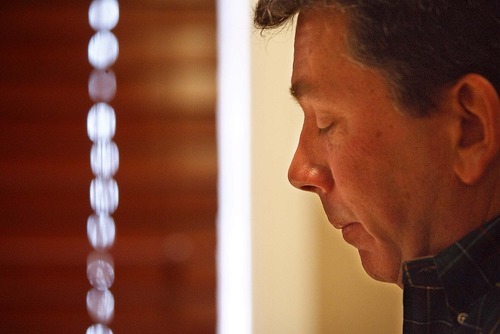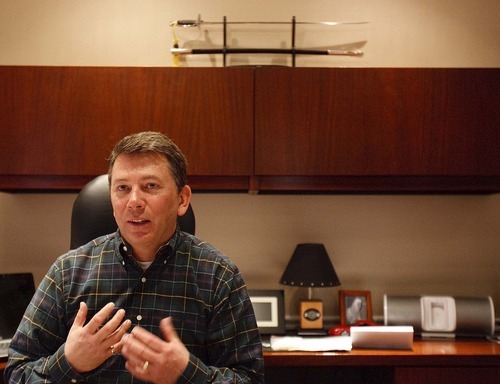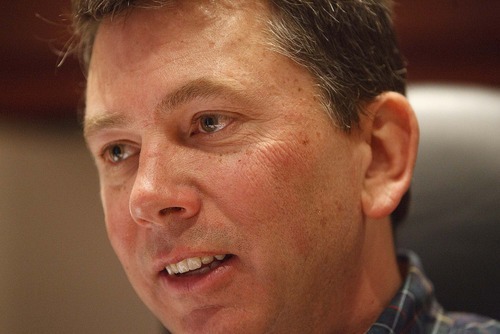This is an archived article that was published on sltrib.com in 2011, and information in the article may be outdated. It is provided only for personal research purposes and may not be reprinted.
Stephen Sandstrom banks his twin-engine plane through the mountains and emerges above Spanish Fork — his eyes alternately scanning the instrument panel and the horizon beyond, where gray sky dissolves into an iced-over Utah Lake.
The plane flattens out at about 8,000 feet above rows of homes. It's quiet, except for the low hum of propellers chopping through the cold air.
"When you look down, you realize all of these lives are going on that you don't know about," he says. "Are they being robbed right now? Is someone being diagnosed with cancer? Is a baby being born?
"You look down at the mass of humanity and it seems so distant from up here."
Minutes later, the 46-year-old banks again and begins his approach to the skinny airstrip. He radios to the tower, nudges the plane's nose up as the wheels touch down with barely a bump.
"I was always good at landings," Sandstrom said.
Back on the ground, Sandstrom gets into his truck — complete with a "Don't Blame Me, I voted for Romney" bumper sticker — and cranks up the heat and talks. The topic, for the most part, is illegal immigration.
It is, all at once, a vexing, passionate, emotional and logical exercise that has consumed his life for the better part of nine months. As the author of an enforcement-only immigration reform bill, he's been at the epicenter of the debate in Utah. Depending on where people stand on the issue, he's been demonized as a racist or lauded as a patriot.
And when the legislative session starts Monday, the Orem Republican and his bill will truly be center stage for the immigration tempest.
—
Arizona echoes • Sandstrom's bill was born shortly after Arizona made national news with its enforcement-only bill. Initially, it mirrored the Arizona law and for much of the year, Sandstrom's bill was always described as an Arizona-style approach.
He tried, unsuccessfully, to get people to call it a "Sandstrom-style" or "Utah-style" approach to the issue. He said his bill would cut out a lot of Arizona's law that has since been tossed out by a federal judge — including the portion of the bill that allowed the questioning of legal status of passengers in a vehicle pulled over for a traffic violation as well as the ability for local police to check residency of people gathered in the parking lots of home-improvement stores.
Sandstrom spent the past few months meeting with dozens of groups to craft and massage the language of his bill, taking out parts to insulate it from court challenges.
He admitted the latest change — removing a part that allowed school officials to question legal status of students and their parents by district officials — cost him some currency among allies on the enforcement side of the issue.
"I don't think I've watered it down," he said. "But the second I decide to make a few changes, I get all kinds of e-mails saying 'You betrayed us.' But I think most people understand what I've done and why I did it."
The changes have come as a result of Sandstrom's seemingly nonstop tour of the state meeting with allies and foes of his legislation.
At a forum at Utah Valley University, he was greeted by some hecklers who branded him a racist. He sat down with the Utah Republican Hispanic Assembly to discuss their concerns with the bill — a scheduled hourlong meeting that extended to almost 3.
Michael Clara, state chairman of the Utah Republican Hispanic Assembly, said there are no changes Sandstrom could make to his bill that would merit an endorsement. But he said while his group disagrees on its premise, he appreciated Sandstrom unveiling it so early in the process.
"I think we'd be hard-pressed to find another representative that is willing to do that — bring out a bill so far in advance and have it held up to scrutiny," Clara said. "As for the changes, well, he was forced to make them because of what the courts have ruled in Arizona."
But Sandstrom isn't easily deterred. Even when lawmakers began meeting to try to merge bills to cut down on the avalanche of legislation — upward of 20 bills — Sandstrom vowed to go it alone.
In many ways, that's because it's who he is.
—
High-risk soloist • Sandstrom's hobbies, at first, read like a list of high-risk, soloist activities. He's a hunter, a motorcyclist, a mountain climber and a pilot.
Sandstrom has been a hunter since he got his first .22-caliber rifle at age 12. His first kill was a mule deer in the Wasatch Front and the passion for the hunt is something that has never left him. To him, hunting is a spiritual endeavor.
"You feel a reverence for the animal," he said. "You feel appreciation. And all of the animals I've shot are eaten. I don't kill them for sport."
The hunt can be a long, painstaking process.
Sandstrom said he's tracked an animal for days in cold, unpleasant conditions. Hunting has taught him patience, perseverance and planning — the latter ranging from learning the anatomical charts of animals he's going to hunt to making his own ammunition.
On his wall in his Orem office — Sandstrom Architects — are more than a dozen heads of impalas from Africa and deer from North America.
He even got his wife into hunting. Prior to their meeting, she'd never fired a gun. The first hunt was difficult.
"I thought, 'Oh my, I'm going to kill it,' " Jennie Sandstrom said. "But it turned out to be like those Native American accounts of hunting. And half of the fun is just being out in nature."
But she won't join him on motorcycles, climbing dangerous mountains or flying a plane.
Sandstrom said he gets a rush out of the adrenaline triggered by these activities.
"You feel most alive when you push out to the edge," he said. "It's a rush."
He's climbed some of the tallest peaks in Ecuador, the tallest mountain in Mexico and the sixth-highest in the Himalayas. He's planning to scale Mount Everest, though he'd like a shot at the more dangerous peak, K-2. His wife won't let him attempt that one, however.
All of those activities, he said, are a part of his personality. Sandstrom described the oxygen-sucking climbs where "you expend so much energy just taking one step" that the reward of accomplishing the hike is "beyond words." He says the activities are calculated risks.
His refuge, however, is motorcycles and planes. On his desktop is a full compliment of Harley Davidson items — lamp, picture frame and blotter. There is a framed picture of him in full leathers on his bike along with son, Haydn, clinging to his waist.
Michael Barth, who has known Sandstrom since they were teenagers at Orem High School, said they often do long, looping motorcycle trips on Highway 150 with frequent stops at waterfalls and pristine scenery. He said those moments are when Sandstrom is at his most reflective.
"We'll discuss things — especially on the Highway 150 ride — we're just in awe of God's creation, where it all began and how we are so small in the entire scheme of the world," Barth said. "We're just one more person in this great big Earth. He says we have a great responsibility to try and protect and enjoy and remember where all of this stuff came from. He realizes he's been blessed with a good job and great family and a wonderful country."
—
Political bug • Politics was always in Sandstrom's blood, ever since his mother used to sit him down and do what he called "The Thought for the Day."
"She'd have the paper and read one of the stories and talk about the politics of the day," he said. "And we'd talk about it at the dinner table, too."
When he was 8, Sandstrom decided to campaign for Richard Nixon in 1972. He got a bunch of fliers and went around town distributing them. He said he stayed up late for the returns and, when it was announced Nixon won, "I was proud to have helped him get elected."
He paused.
"Of course, at the time, I didn't know what a scumbag he was," Sandstrom said.
But the political bug was planted. He fed his hunger by joining the debate team in high school. Between that and getting his pilot's license at 17, Sandstrom said he saw everything falling into place.
"He had a certain pie-in-the-sky mentality then," Barth said. "But as he grew up and things happened, he did what he had to do."
That included giving up on being a pilot.
Sandstrom, after a short stint in the Marines, hooked up with SkyWest and US Airways — flying regional routes along the Eastern Seaboard and the Midwest. He loved being in the air and thought he'd do it for the rest of his life.
But he'd also decided to take a stab at politics — running for an open Orem City Council seat in 1993. He won three terms. Because his flight schedule forced him to miss so many meetings, however, he knew he was going to have to make a change.
His father, who had run a successful architectural firm, had a stroke in 1991. Sandstrom, who had studied the craft under his father as a teenager and young adult, received his license in architecture. He decided to try to keep his father's business going, engage in politics more and then returned to flying a few years later. But US Airway's bankruptcy filing post-Sept. 11 ended his professional piloting career.
"At first I tried to do it all, but it wasn't working," he said. "We had a lot of employees that were relying on me and so I walked away from flying."
He soon found architecture suited him. His firm primarily does schools, and he said his philosophy is to integrate a region's ecology and history into the design. He is largely critical of Utah's architecture, and the fact that home designers can practice without a license.
"I hate seeing a glass building in the middle of something and there's no relationship there," he said.
—
Utah Legislature • When Sandstrom was elected to the House in 2006, he joined a cadre of similar-minded conservative lawmakers that believed strongly in states' rights and limited government and opposed in-state tuition for undocumented students as well as the driving privilege card passed by the House in 2005. He is an unabashed fan of President Ronald Reagan, even naming one of his children after the former president.
In his office, a portrait of Reagan hangs on the wall, looking over his shoulder. He is aware of the irony that the amnesty bill signed by Reagan in 1986 is viewed as a colossal mistake among those who support tough immigration restrictions.
"It was a mistake," Sandstrom concedes. "But he also thought that once he signed it, the border would be secured and it wasn't."
Rep. Chris Herrod, who filled in for Sandstrom for some meetings on the enforcement-only bill, said his colleague's bill could make an impact on Utah. He also said Sandstrom is the perfect person to carry this bill forward because his travels around the world serve him well when dealing with the thorny issue.
"He's seen the misery around the world, and it's easy for people who don't know him to say he's not compassionate, but he sees how fortunate we are in this nation and wants people to come to this country legally," Herrod said, noting Sandstrom has sponsored people to come.
Sandstrom, who is fluent in Spanish after his LDS mission in Venezuela, said the attacks on him as a racist don't bother him. He said he is operating out of conviction and said it's not about race at all.
But he said he expects those shouts will continue as the session starts and the debate begins on his bill.
But he's been planning for this moment, just the way he maps out routes on a steep mountain climb or files a flight plan before taking off, taking into account weather and obstacles along the way and knowing it's the landing that people remember the most.
Stephen Sandstrom
Age • 46
Home • Orem
Orem city councilman • 1993-2006
State House • 2006-present
Education • Graduate of BYU in political science, attended Arizona State University and got architecture license
Family • Four children: Afton, 19; Jesse, 16; Reagan, 14; Haydn, 10
Current occupation • Owner of Sandstrom Architecture











